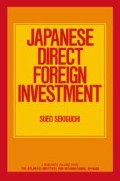Abstract
It is clear that direct investment is different from the export of capital as funds. As long as there exist relatively redundant managerial resources, the other requirements for investment can be met in the international capital market. With current financial practice, however, a certain percentage of the initial investment is likely to be provided by the investing firms themselves or by those who are well acquainted with the prospective profitability of the project. In other words, some organizations or individuals have to take the large initial risk. In this context, it would be appropriate to examine the balance of payments structure of Japan since such risk-takers are usually in the investing country.
Access this chapter
Tax calculation will be finalised at checkout
Purchases are for personal use only
Preview
Unable to display preview. Download preview PDF.
Notes
Kiyoshi Kojima, Theory of Direct Foreign Investment, Daiyamondosha, Tokyo, 1976. Available in Japanese only. Raymond Vernon, “International Investment and International Trade in the Product Cycle,” Quarterly Journal of Economics, May 1966, p. 199.
These points are derived from the results of a survey of Japanese subsidiaries in Thailand, presented in Toshio Shishido, Nikko Research Center, A New Era of Japanese Foreign Investment, Toyokeizai Shinposha, Tokyo, 1977. Available in Japanese only.
An example is that the report insists at many points on intervention by investing country governments while it also argues for host countries’ autonomy in regulating multi-national corporations. Ryutaro Komiya made a detailed critical review of this report in Study on International Economy, Iwanamishoten, Tokyo, 1975, Chapter II. Available in Japanese only
All these documents are recorded in Hiroshi Fukuda (ed.), Guidelines for Activities of Multinational Corporations, Jijitsushinsha, Tokyo, 1976. Available in Japanese only.
Copyright information
© 1979 Atlantic Institute for International Affairs
About this chapter
Cite this chapter
Sekiguchi, S. (1979). Conclusion. In: Japanese Direct Foreign Investment. Palgrave Macmillan, London. https://doi.org/10.1007/978-1-349-81406-0_5
Download citation
DOI: https://doi.org/10.1007/978-1-349-81406-0_5
Publisher Name: Palgrave Macmillan, London
Print ISBN: 978-1-349-81408-4
Online ISBN: 978-1-349-81406-0
eBook Packages: Palgrave History CollectionHistory (R0)

